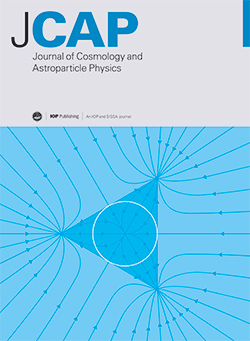Scalaron dark matter and the thermal history of the universe
IF 5.3
2区 物理与天体物理
Q1 ASTRONOMY & ASTROPHYSICS
Journal of Cosmology and Astroparticle Physics
Pub Date : 2024-12-12
DOI:10.1088/1475-7516/2024/12/028
引用次数: 0
Abstract
In metric f(R) gravity minimally coupled to the Standard Model, the scalaron field can act as a dark-matter candidate if its mass lies in the range meV ≲ m ≲ MeV. The evolution of the scalaron is influenced by the trace of the stress-energy tensor, whose behaviour, as shown in our previous work, becomes non-adiabatic during the electroweak crossover, potentially triggering scalaron oscillations. While we previously approximated this crossover as a second-order phase transition at the one-loop level, the transition is actually smoother. In this paper, we refine our analysis to account for this smooth crossover and show that scalaron oscillations are still excited in a qualitatively similar manner, driven by the rapid dynamics of the electroweak crossover observed in numerical lattice simulations, provided the scalaron mass is sufficiently small. We also investigate the time-dependent contribution to the stress-energy trace due to the trace anomaly of quantum chromodynamics. Our results indicate that, while the trace anomaly shifts the scalaron's equilibrium value, this shift evolves adiabatically compared to the fast oscillations of the scalaron, meaning that the trace anomaly does not significantly affect the potential cosmological scenarios for scalaron evolution.暗物质和宇宙的热历史
在与标准模型最小耦合的度量f(R)引力中,如果标量场的质量在meV > m > meV范围内,则它可以作为暗物质的候选者。scalaron的演化受到应力-能量张量痕迹的影响,正如我们之前的工作所示,其行为在电弱交叉期间变得非绝热,可能引发scalaron振荡。虽然我们之前将这种交叉近似为单回路水平的二阶相变,但实际上这种过渡更平滑。在本文中,我们改进了我们的分析,以解释这种平滑交叉,并表明,在数值晶格模拟中观察到的电弱交叉的快速动力学驱动下,如果标量隆质量足够小,标量隆振荡仍然以定性相似的方式被激发。我们还研究了由于量子色动力学的痕迹异常而导致的应力-能量痕迹的时间依赖性贡献。我们的研究结果表明,虽然痕量异常移动了标量朗的平衡值,但与标量朗的快速振荡相比,这种移动是绝热的,这意味着痕量异常不会显著影响标量朗演化的潜在宇宙学情景。
本文章由计算机程序翻译,如有差异,请以英文原文为准。
求助全文
约1分钟内获得全文
求助全文
来源期刊

Journal of Cosmology and Astroparticle Physics
地学天文-天文与天体物理
CiteScore
10.20
自引率
23.40%
发文量
632
审稿时长
1 months
期刊介绍:
Journal of Cosmology and Astroparticle Physics (JCAP) encompasses theoretical, observational and experimental areas as well as computation and simulation. The journal covers the latest developments in the theory of all fundamental interactions and their cosmological implications (e.g. M-theory and cosmology, brane cosmology). JCAP''s coverage also includes topics such as formation, dynamics and clustering of galaxies, pre-galactic star formation, x-ray astronomy, radio astronomy, gravitational lensing, active galactic nuclei, intergalactic and interstellar matter.
 求助内容:
求助内容: 应助结果提醒方式:
应助结果提醒方式:


